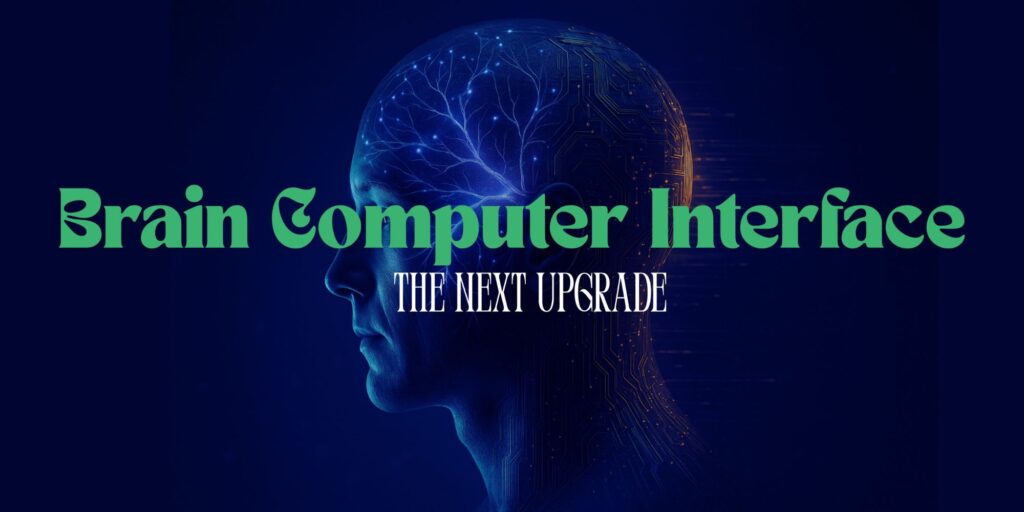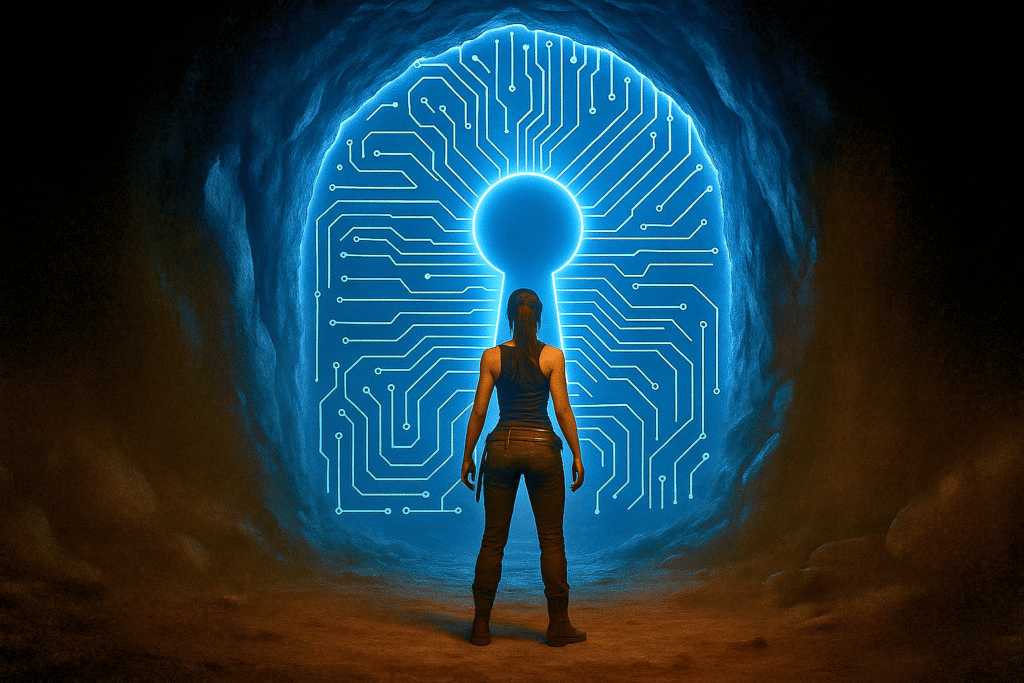TL;DR – BCIs connect the human brain directly to machines. BCIs are classified into 3 types – invasive, semi-invasive and non-invasive. BCI market is expected to grow from USD 2.94 billion in 2025 to USD 12.4 billion by 2034. This raises many questions such as privacy, security and ownership of our neural data. There aren’t any laws in place to deal with when BCIs become popular.
Noland Arbaugh was a 23 year old student working at a kids’ summer camp. One day while diving into the water, he struck his head. In the blink of an eye, his life had changed. He dislocated his neck. His vertebrae went back in place almost instantly but his spinal cord was severely damaged. This left him paralysed below the shoulders.
He needed someone for each and every activity. Just to go online or send a private message, he needed someone’s help.
After seven to eight years, one of his friends informed him about the human trials by Neuralink. He immediately volunteered. In a few months, a chip was implanted in his brain.
Elon Musk calls it telepathy but Noland calls it Eve.
Now 30 years old, he is ecstatic. Once his chip successfully connects to his laptop, he can play games, use social media, write emails and more. His Neuralink chip lets him control the cursor with his thoughts. Elon Musk calls it “telepathy”.
He tells The Guardian that he likes to call his chip Eve. “Neuralink and I, we’re on the eve of something great, so that works out perfectly, too. Also – Adam and Eve. God created Adam, and then gave Adam a helper, who is Eve. I’m Adam, in this scenario, and Eve is my helper,” he says to The Guardian correspondent.
For a quadriplegic, every action needs another person’s help. It’s not any different for Noland, either. But this chip gives him something we all take for granted, our own online independence.
It’s not just Neuralink that’s working on brain-computer interfaces (BCI), but many others around the world. This technology aims to make people like Noland more independent. Maybe this very technology could help them move, drive and do things like anybody else. You can be certain of this though, each tiny step will be a freaking unbelievable step for humankind.
What are brain-computer interfaces (BCI)?
Our thoughts are just electrical pulses that needs to be decoded.
A brain-computer interface (BCI) is a device that establishes communication between the brain and an external device.
Every thought and movement generates the firing of neurons in our brains. This is detected by the BCIs and interpreted using algorithms.
Communication can happen both ways. One-way BCIs like the Neuralink chip used by Noland, read the signals from the brain. Two-way BCIs read signals from the brain and also transmit signals to the brain. As reported by TheHill.com, researchers from the University of Pittsburgh successfully helped a quadriplegic patient Nathan Copeland by implanting a two-way BCI in his brain. He is able to control a prosthetic arm and also feel things with it. Here, the communication happens both ways – signals to control the prosthetic arm are transmitted from the brain to the arm and sensory signals from the arm are transmitted to the brain. The sensory feedback apparently gave him more control.
Types of BCI
More risk better signal.
BCIs are classified into three types based on how close they are kept near your brain.
Invasive BCI
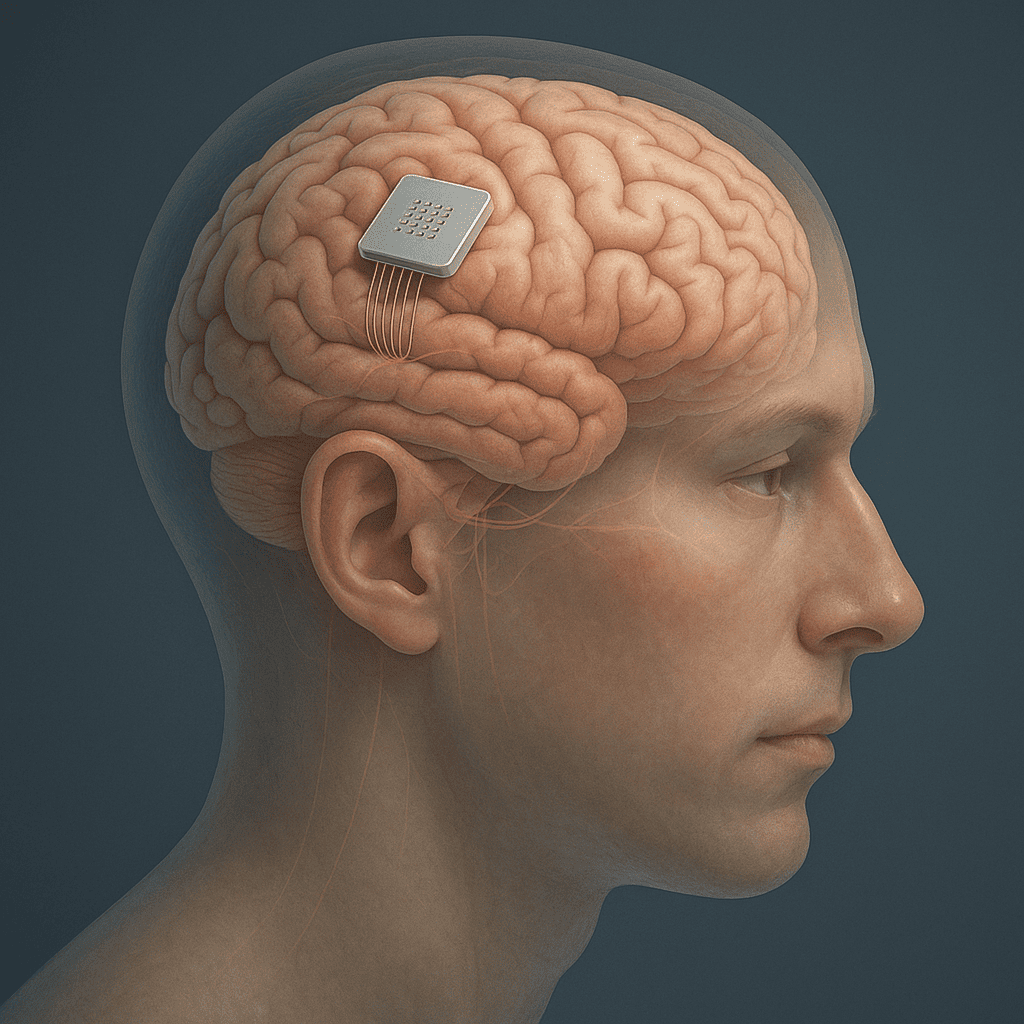
Invasive BCI is surgically implanted in the brain tissue. Since the sensor sits in the brain, they can pick up even the slightest signals.
Invasive BCIs are currently used for medical and research applications. Since these involve brain surgery, there is a big risk of developing infections.
Some examples are Neuralink’s N1 chip, Blackrock Neurotech’s Utah Array, Paradromics.
Semi-Invasive BCI
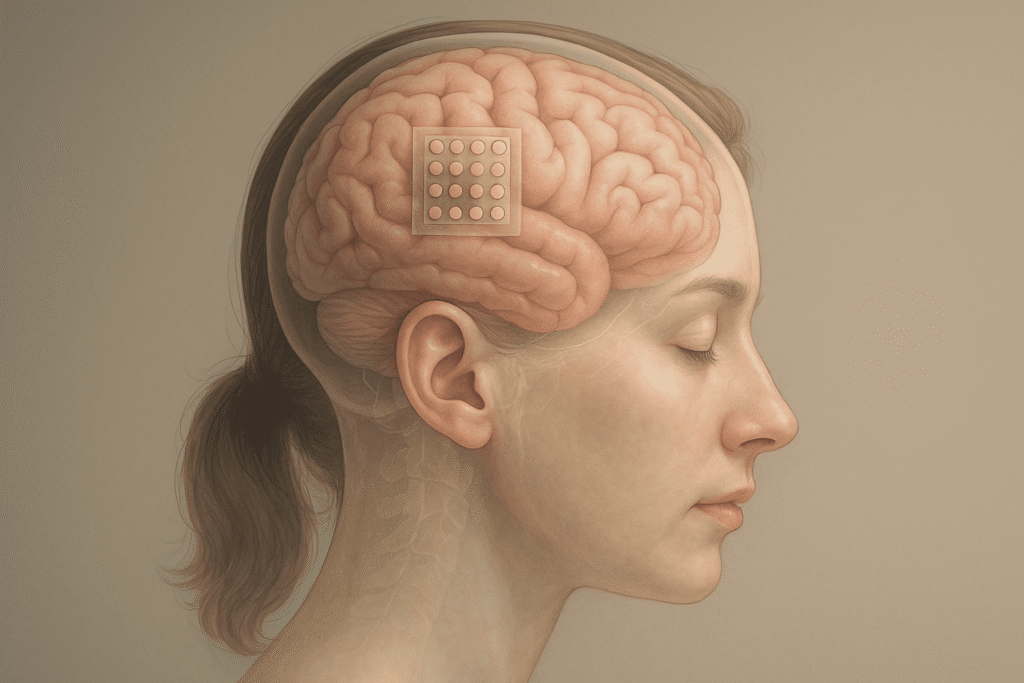
For a semi-invasive BCI, the electrodes are placed on the surface of the brain. They use a method called ECoG (electrocorticography), where sensors rest on the brain’s outer layer.
This method avoids penetrating the brain and is safer than invasive BCIs. The signals received or sent are not as strong as those from invasive BCIs.
An example would be the Synchron’s Stentrode which is inserted into the blood stream and expands near the motor cortex.
Non-invasive BCI
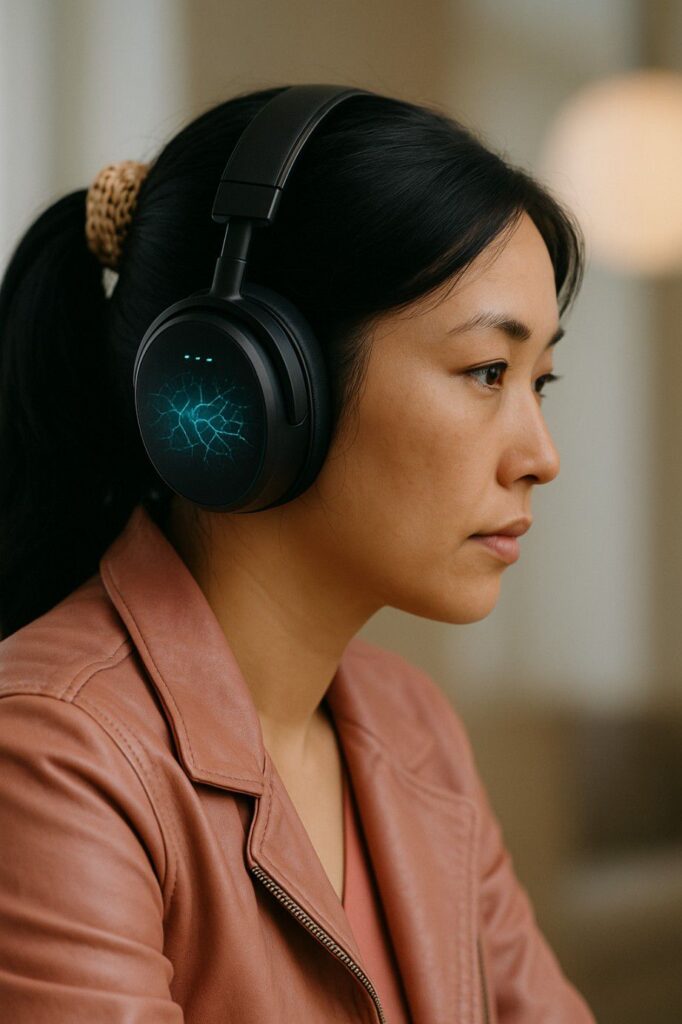
Non-invasive BCIs are worn outside the head. They come in the form of helmets, headsets etc. They rely on external sensors placed on the scalp to record the electrical activity of our neurons (EEG) or blood flow changes (fNIRS).
They can be bought and used by people without any surgery.
The signals are noisier and weaker because they pass through the skin and skull. They can track attention, stress and intention.
Examples are Emotiv or Neurable EEG headsets, Kernel Helmets and others.
Consumer EEG headsets (Emotiv, Neurable, etc.) can detect attention/relaxation and support simple controls in demos and some games. They cannot reliably decode complex thoughts or full natural typing. You can buy them now for basic applications.
How does BCI work?
BCIs translate our thoughts to action.
BCI works by combining engineering and biology.
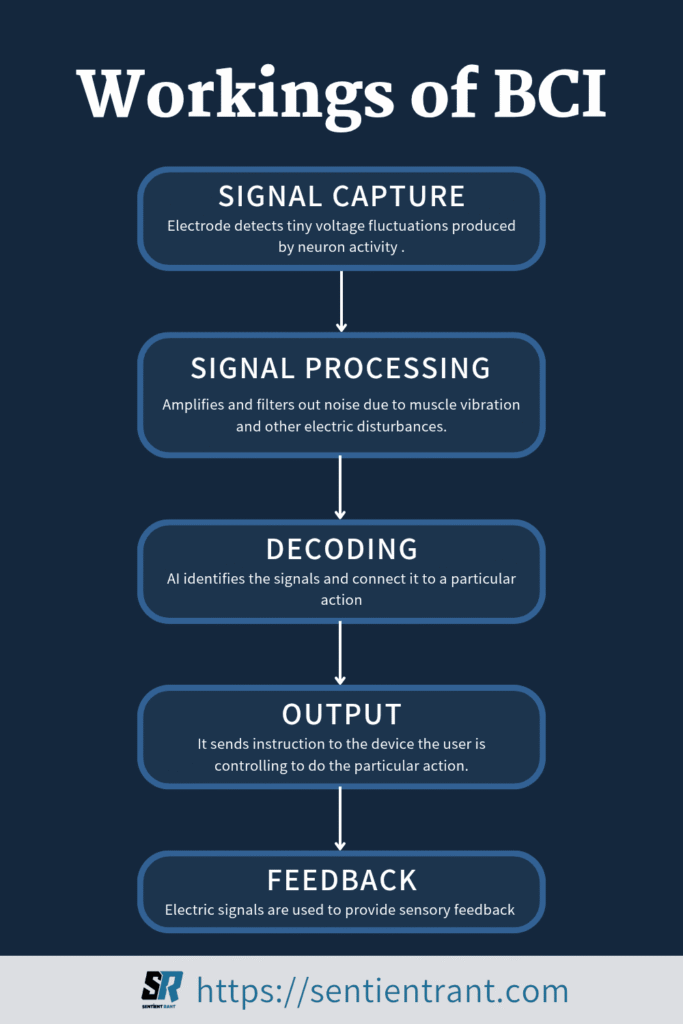
Signal capture
Every thought we have starts with electricity. When we imagine moving our hands, clusters of neurons fire in a particular part of the brain. Electrodes capture these tiny voltages. The signals are too weak and are in microvolts. The closer the electrodes are to the brain, the better the signal is received. This is why invasive BCIs are better at detecting signals than non-invasive ones.
Signal processing
The signals received are very feeble and full of noise. Noise could include muscle vibration or other electric disturbances.
These signals are therefore amplified and passed through filters to isolate the brain waves.
Decoding
The next step is to interpret what these signals mean. AI models are trained to understand the brainwaves. Over time the system learns what specific brainwaves mean and what corresponding action is intended.
Output
The processed output is sent to the equipment which the person is controlling and the intended action is done. All of this works quickly and flawlessly.
Feedback
In one-way BCI, the process will end at the previous stage. But for a two-way BCI system, it sends back feedback through electrical stimulation usually sensory feedback from a prosthetic arm.
A brief history of BCI
BCIs didn’t pop out just like that.
The idea of a brain-computer communication didn’t just start with Elon Musk as many think. It started many years ago.
1960s-1970s
In 1969, researchers at the University of Washington showed that monkeys could change the movement of a dial using brain signals alone. The first paper on EEG (electroencephalography) was published in 1973 by Jacques Vidal and in it he coined the term BCI (Brain-computer interface).
1980s-1990s
Niels Birbaumer and Jonathan Wolpaw developed EEG-based communication systems that allowed paralyzed patients to select letters on a screen. The system was slow and sometimes imperfect.
In 1999, researchers at Duke University demonstrated that a monkey could control a robotic arm through its motor cortex.
2000s
In 2004, Matthew Nagle, paralyzed from the neck down, became the first human to move a computer cursor using thought. It was achieved by the BrainGate team – a collaboration between Brown University, Cyberkinetics Neurotechnology Systems, and Massachusetts General Hospital (MGH).
2010s: Touch, Movement, and the Rise of AI
Wireless data transmission started replacing wires and cables, and machine learning began to decode neural activity in real time.
In 2012, researchers at the University of Pittsburgh helped a paralyzed woman, Jan Scheuermann, use a robotic arm to feed herself by thought.
By 2016, this same team achieved something extraordinary. They restored the sense of touch through electrical stimulation of the brain’s sensory cortex. For the first time, a human could feel through a machine.
2020s: The Commercial Age
Companies around the world started developing real BCI based products.
Neuralink, founded by Elon Musk in 2016, developed its N1 implant and performed its first human implantation in 2024 on Noland Arbaugh, who can now operate a computer purely by thought.
Synchron, founded by Thomas Oxley, created the Stentrode. A tiny electrode array that can be inserted through a blood vessel, avoiding open-brain surgery. It became the first BCI to receive FDA approval for U.S. human trials in 2021.
Blackrock Neurotech and Parandromics continue to work on high-bandwidth implants designed for speech restoration and complex motion control.
In 2025, the global brain–computer interface market is valued at roughly USD 2.94 billion. According to GlobeNewswire, it is expected to reach USD 12.4 billion by 2034. Surprisingly, it is performing better than robotics and VR.
Today this field is not limiting itself to restoring function but it is exploring the possibility of controlling devices with just thought.
Concerns and ethical risks of BCI
Imagine signing off our thoughts to a company to use their product.
BCIs study the brain which is one of the most private and the most important organs in our body. This is why the game changes when BCIs become mainstream.
Privacy
Our brain is where our thoughts generate. It is private as of now. But going forward as BCIs become mainstream tech, there are concerns that our thoughts won’t be private anymore.
Our thoughts could be used for marketing and other activities.
Companies already trick us into signing very elaborate “Term and Conditions” with hidden clauses and unfair terms disguised in lawyer language just to use their products. Will we have to sign off our neural data the same way to use these products?
As of now, most countries haven’t implemented any laws to protect brain data.
Chile became the first country to add neuro-rights to its constitution in 2021 focusing on mental privacy and cognitive liberty.
Security
Just like any devices, BCIs can also be hacked. Many researchers have already hacked BCIs to prove it’s possible.
The University of Alabama at Birmingham (UAB) study (2017) demonstrated that consumer EEG headsets can be compromised. Malicious software could study brain waves and steal passwords and PINs if the user is wearing the headset while using a banking app or performing a transaction.
Researchers from MIT demonstrated they could trick BCIs by using radio signals to fake brain waves. They successfully hijacked a virtual keyboard, a drone interface and also fooled a consumer meditation headset with fake calm readings.
As a result, there should be stringent laws that stresses on encrypting messages between the BCI and devices with E2EE encryption or something better.
Ownership issue
When algorithms and humans control a device, who is going to really control it? Similar to the autocorrect feature on our smartphones, algorithms could predict our next action and do it before we think about them. Participants in many trials have reported that they are unsure whether they thought the particular action or the BCI just predicted it. If such an action creates an unfavorable outcome, who would be responsible?
Vendor issue
For example, the company that provided the invasive BCI shuts down or stops the service. What will be the next option? We won’t be able to think of it with a nonchalant attitude “No worries, let’s get a new one.” It is a very serious problem as it is the brain. Standards have to be implemented and portability should be seamless so that shifting from one brand to another isn’t difficult.
The next upgrade
Ready or not. Technology is going to get a serious upgrade.
BCIs are going to be our future. Looking at the present technology we see around us, we can definitely imagine using BCIs incorporated in it. Personally, I feel it could enhance our gaming experience, or add depth to our VR experience or play the song on our headphones as we imagine or help us communicate with an AI chatbot on the go with our minds.
BCIs aren’t just about making our lives easier. For millions who are bedridden, living with paralysis, BCIs offer a new hope for them to return to a normal and independent life.
Everything depends on how ready we are both socially and legally. Ready or not? The next upgrade is already here.
Think of some crazy applications of BCIs you think will happen in the future. Let us know in the comments.
FAQs
Its a system that helps you communicate with an external device with your mind.
BCIs detect tiny electrical pulses caused by neurons firing in our brain. These signals are then amplified and filtered. Algorithms interpret these signals and sends signal to the external device to perform the activity. Some advanced BCIs are capable of sending sensory feedback to the brain.
There are three main types:
Invasive BCIs: Implanted directly in brain tissue. Highly accurate but require surgery.
Semi-invasive BCIs: Electrodes rest on the brain’s surface. Safer, with moderate precision.
Non-invasive BCIs: Worn externally as headsets or helmets. No surgery, but lower signal quality
BCIs are used in medical rehabilitation for paralyzed patients, prosthetic control, communication aids, and even gaming or mental health monitoring
No. Neuralink is the most publicized, but other key players include Synchron, Blackrock Neurotech, and Paradromics. Synchron’s Stentrode is notable for using blood vessels to access the brain without open surgery.
The global BCI market was valued at around USD 2.94 billion in 2025 and is projected to grow to USD 12.4 billion by 2034, driven by healthcare, gaming, and neurotechnology industries.
Yes, in theory. Studies from MIT and the University of Alabama have shown that BCIs can be manipulated or used to extract data like passwords if compromised. Future BCIs will need advanced encryption possibly end-to-end or quantum-safe security or something better to prevent hacking.
Major ethical concerns include privacy, data ownership, consent, and control. If a BCI predicts actions before we consciously decide them, it raises questions about free will and accountability.
Possibly in niche areas first. BCIs will likely enhance, not replace, current interfaces — especially for people with disabilities, gamers, and researchers. Full “mind typing” or thought-to-text is still in experimental stages.Possibly in niche areas first. BCIs will likely enhance, not replace, current interfaces — especially for people with disabilities, gamers, and researchers. Full “mind typing” or thought-to-text is still in experimental stages.
Expect BCIs to merge with AI assistants, smart devices, and AR/VR environments. In the long run, they could allow communication without speech or typing — literally, mind-to-mind interaction. The only question is how much control we’re willing to give away.
Check out our other posts
How VPNs really work: Protocols, safety and myth
Passkeys Explained: The End of Passwords or Just Another Tech Gimmick?
The real cost of free apps
183 Million Gmail addresses in a data leak — Here’s what actually happened (and what you should do)
How WhatsApp Uses the Signal Protocol (X3DH + Double Ratchet) Explained in Simple Words
DNA data storage: Replacing hard drives with DNA
Hard drives fade. DNA endures. Discover how scientists are turning life’s own…

